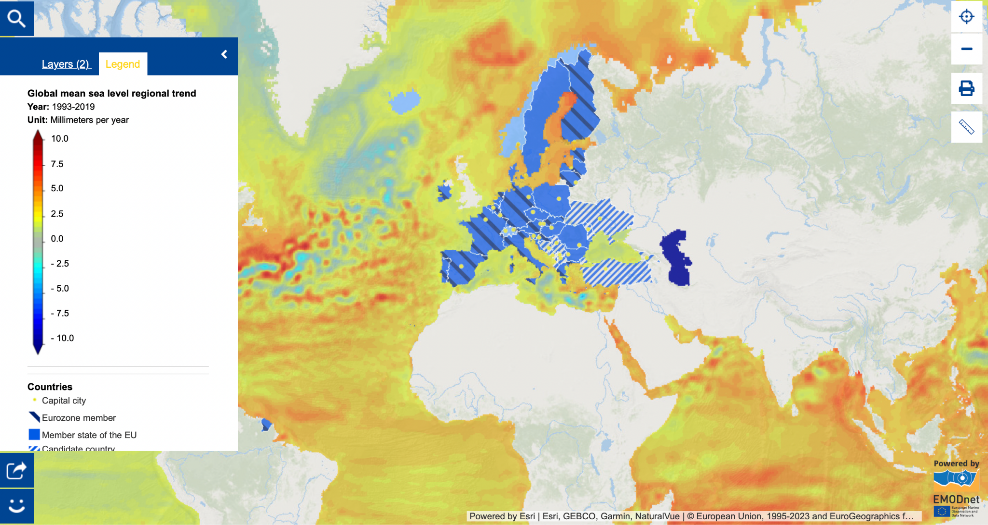
“We recognise climate change-related sea level rise disproportionately impacts Small Island Developing States (SIDS), Least Developed Countries (LDCs) and coastal communities, especially in developing countries, and acknowledge the urgent need for greater international cooperation and collective action to enhance their adaptive capacities and build resilience while mitigating climate change. We are determined to strengthen international cooperation to support those who are particularly vulnerable to the adverse effects of climate change.” This statement is included in the 3rd United Nations Ocean Conference (UNOC3) declaration, which was adopted on 13 June 2025.
During UNOC3 which took place in Nice (France), visitors of the Green Zone dedicated to the general public, referred to as the Whale, were able to learn more about sea level rise and islands. The European Digital Ocean Pavilion hosted a session on sea level rise on 11 June 2025. The Pavilion France, Three Oceans was a meeting place for the French overseas territories. From French Guiana to Polynesia, via Mayotte, Reunion and the West Indies, these territories embody an ocean diplomacy based on knowledge, cooperation and resilience. Through its flagship themes - marine ecosystem protection, carbon capture by mangroves, indigenous knowledge, coastal adaptation, marine biotechnologies - the pavilion showcased concrete solutions to global challenges.
Did you know there is a map layer on sea level trends in the European Atlas of the Seas? This week, the Map of the Week focuses on this topic. First, let’s look at what makes the sea level rise.
Barystatic sea level change refers to changes in water masses from melting ice sheets and glaciers, water storage changes and influx of water from the land into the ocean. [1]
Change in ocean volume or density, also known as steric sea level change, is due to temperature and salinity changes regionally and, at global scale, to thermal expansion of the ocean in response to warming. [1]
Between 1901 and 2018 the global average sea level increased by 20 cm. The rate of sea level rise is increasing. [1] Scientists work with climate models to develop sea level rise projections (i.e. estimates of future sea levels). [2] They carry out simulations with the models to study possible future situations. These simulations are carried out with different greenhouse gas emissions scenarios. Our choices of today will define our future. The Intergovernmental Panel on Climate Change (IPCC) estimates that, by 2050, the global sea level is expected to rise between 15 and 30 centimeters, on average. [3]
Coastal communities are the first to experience the negative effects of rising sea levels. They face increased likelihoods of floodings, storms, tropical cyclones, shortages of freshwater due to saltwater intrusion, shoreline retreat due to increased erosion and more. [1,2] This puts at risk coastal communities’ infrastructure and food security. [1]
How do coastal communities cope with sea level rise? Sea level rise is for many countries mainstreamed in national and regional policies for climate adaptation, spatial planning and environmental conservation. [2] Adaptation strategies include preparing for hazards through early warning systems, using saltwater proof material in construction, employing hard and soft defense material, advancing land through conservation, and adopting relocation strategies. [1] Nature-based solutions play a huge role in mitigating sea-level rise! [4]
This is an important concern for people living on Islands, relying heavily on the ocean for their wellbeing. Small island nations' ocean exports are 10 times higher per capita than the global average. [5] Small Island Developing States (SIDS) are a group of islands that make up less than 1% of the world population but face remarkable social, economic and environmental challenges. They are at the frontlines, stewarding our global common ‘the ocean’ but also sounding the alarm bell and showing their leadership. Circling back to the statement in the UNOC3 Declaration: SIDS are disproportionately impacted by sea level rise. Acknowledged in the Declaration [6] as well, SIDS have shown leadership in the past through:
- The 2021 Pacific Islands Forum Declaration on Preserving Maritime Zones in the Face of Climate Change-Related Sea Level Rise;
- The 2021 Alliance of Small Island States Leaders’ Declaration;
- The 2023 Pacific Islands Forum Declaration on the Continuity of Statehood and the Protection of Persons in the Face of Climate Change-Related Sea Level Rise;
- The 2024 Alliance of Small Island States Leaders Declaration on Sea Level Rise and Statehood.
Wish to learn more?
- Learn more about sea level rise in Sri Lanka and Papa New Guinea;
- Browse through islands engaged with the Small Islands Organisation (SMILO);
- Read about photographer Christian Clauwers’ journey from Antarctica to the Pacific;
- Have a look at the European Atlas of the Seas’ slideshow showcased at the European Digital Ocean Pavilion.
All the best to teachers and students currently working on exams!
The data in the map is provided by Copernicus Marine Service.
[1] https://sp.copernicus.org/articles/4-osr8/1/2024/
[2] https://oceandecade.org/publications/first-european-assessment-report-on-sea-level-rise/
[3] https://press.un.org/en/2024/sea2199.doc.htm
[4] https://news.stanford.edu/stories/2022/06/nature-defense-sea-level-rise
[6] https://www.un.org/pga/wp-content/uploads/sites/109/2025/05/UNOC3-declaration-final.pdf
